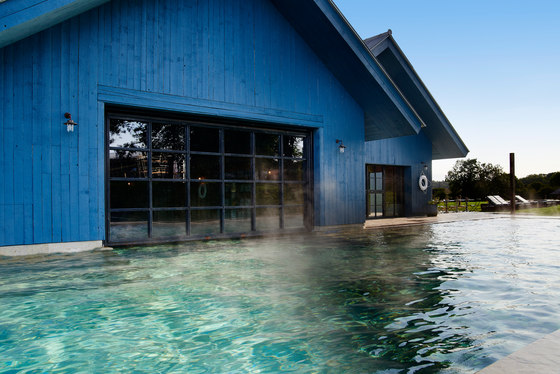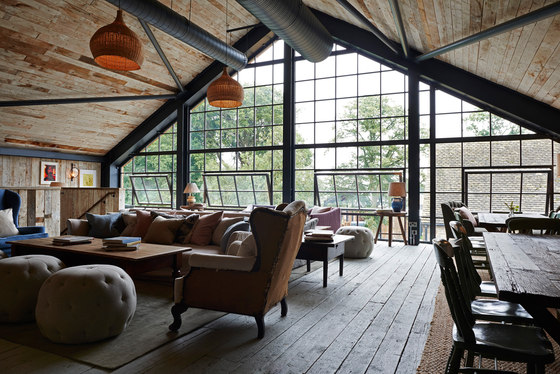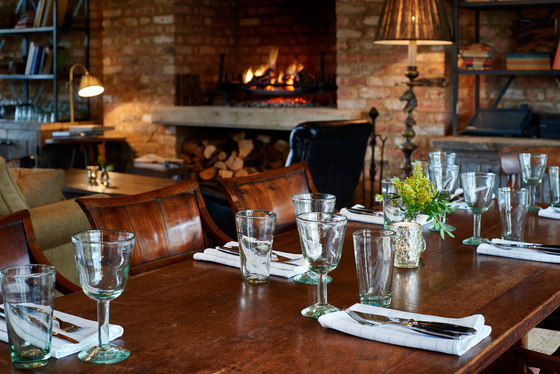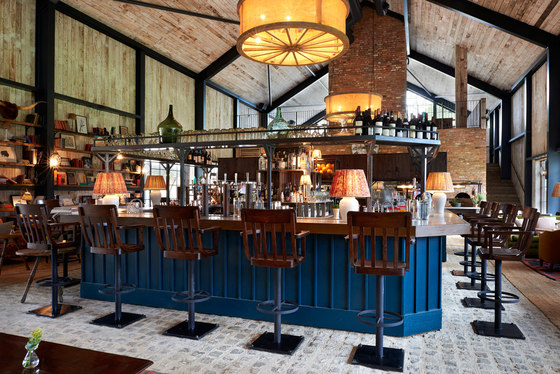Soho House & Co’s in-house design team collaborated with London-based architecture practice Michaelis Boyd on the development of Soho Farmhouse, the new countryside retreat set across 100 acres of rolling countryside in Great Tew, a village in the Oxfordshire countryside. Soho Farmhouse includes 40 individually-designed cabins assembled around original farm buildings, complemented by the addition of contemporary new buildings. Michaelis Boyd worked alongside the Soho House design team on the Main Barn, Boathouse, Gym and Yoga Studios, Electric Barn Cinema, and the Steam and Sauna Island.
Michaelis Boyd has worked with with Soho House since 1995 on the design of many of their projects in the UK and internationally, including the original Soho House on Greek Street in London, The Electric, Babington House, Soho House Berlin, and Soho House LA, and were instrumental in turning this ambitious new project into reality. Alex Michaelis, co-founder of Michaelis Boyd commented: “We were delighted to be asked to work with the Soho House in-house design team to prepare an initial planning document and architectural drawings for some of the final buildings at Nick’s latest venture, a second countryside retreat for Soho House. Tracey Farm was a derelict Cotswold farmhouse on Nick Johnston’s beautiful Great Tew estate and it has been transformed into a beautiful open space, where many original features were reintroduced to preserve a farmhouse feel.”
Main Barn
The 805m squared Main Barn is the heart of the farm, where guests congregate for drinks and food. It has large areas of glazing opening up to the Farm Yard, letting morning and evening light flood into the central space. To the east and west of the building, large glazed gable ends allow indirect natural light into the mezzanine dining areas as well as into the central bar and dining area at ground floor level. A balcony and glazed canopies were introduced to provide views over the courtyard, lake, Boathouse and gym. The walls are finished in timber board that was reclaimed from a previously demolished barn. Cobbled stone flooring is used on the ground floor and reclaimed timber floorboards on the mezzanine levels. Crittall-style glazing has been incorporated, as well as reclaimed chicken-wire corrugated glass from America for the terrace roof covering.
The Boathouse
The 1590m squared Boathouse, incorporates a 16 metre indoor pool that extends to a 25 metre outdoor deck-level pool that appears to float within a lake. The pool hall was designed to replicate the feel of a working boathouse and the specialist pool finish was selected to resemble the Cotswold stone used in the surrounding buildings. The Boathouse comprises a series of interlinked gable-ended structures that are carefully staggered to reduce the visual mass of the building. The low building height and unassuming building form conceals a large area within the basement level that houses a spin studio, changing facilities, steam and sauna room and ancillary plant rooms.
Gym and yoga studios
The gym and yoga studios are the most contemporary additions to the farm. Sited on an east-west axis, the largely glazed eastern façade takes in the views of the central valley of the farm. To the north, an enclosed pavilion is linked to a secluded landscaped area that is used for yoga – a quiet space for meditation and contemplation. The main gym spaces are zoned loosely for cardio, weights and personal training. The internal finishes are minimal, with an expressed saw-tooth ceiling punctuated by a series of Anton De Groof’s sculptural pendant light fittings. The walls are finished in blackened timber boards externally and white painted boards internally. Cork flooring is used throughout, with rubberised linoleum in the weight training areas.
Electric Barn Cinema
The Electric Barn cinema was developed to be visually unassuming externally, with corrugated metal cladding for the roof and walls, and low level painted brick. The building is linked to both the Greenhouse and Kitchen Garden. Internally, the 390m squared screening room is fitted with velvet armchairs and individual tables with lamps. As with the original Electric cinema in Portobello, London, individual cashmere blankets are offered for extra comfort. Herringbone floorboards line the lobby floor, alongside checkerboard porcelain floor tiles in the common areas, and carpet in the screening room. The screening room walls are clad with walnut veneered panelling and acoustic fabric walling.
Steam and Sauna Island
The steam, sauna and ice room pavilions were designed to resemble a series of small-scaled self-built huts. The steam and sauna rooms are separated by a glazed roof walkway, leading to two raised hot tub platforms that open out to the privacy of the old Upper Mill Pond. The pavilions were placed strategically between the Upper Mill Pond and the new Lower Mill Pond, carefully avoiding the tree root protection zones. To the north of the island, the decking connecting the island to the Cowshed building lowers and floats above the Lower Mill Pond level, forming a jetty for rowing boats. The resulting building placement also prevents the wind from blowing towards the outdoor hot tubs.
Michaelis Boyd Associates















































